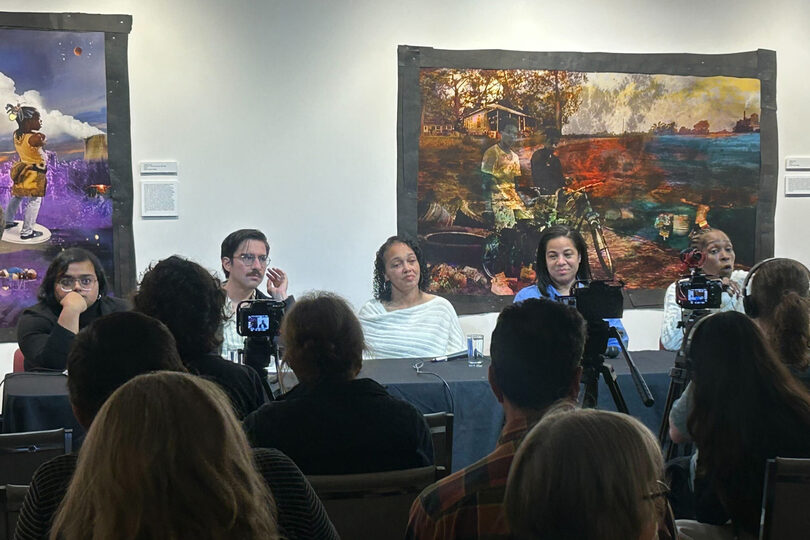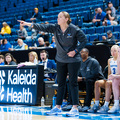City lead advocates share concerns on I-81 deconstruction, projected impact

Syracuse lead advocates shared environmental concerns over the deconstruction of the I-81 viaduct, which is set to start in the summer of 2026. The panelists discussed the potential of harmful chemical exposure to residents near the construction. Brenne Sheehan | Asst. News Editor
Get the latest Syracuse news delivered right to your inbox.
Subscribe to our newsletter here.
As the deconstruction of the I-81 viaduct is slated for 2026, Syracuse lead advocates shared environmental concerns about the project at a Wednesday panel hosted by Central Current.
The panelists discussed the demolition project’s potential impacts on residents in the 15th Ward — a historically Black district of Syracuse containing the Southside neighborhood — during its ongoing lead and water crisis, and highlighted their contribution to the project’s planning so far.
The discussion, moderated by Central Current reporters Eddie Velazquez and Debadrita Sur, featured three panelists — Lanessa Owens-Chaplin, director of the Racial Justice Center at the New York Civil Liberties Union, Oceanna Fair and Darlene Medley, co-chairs of Families for Lead Freedom Now!
Community advocates have called for the removal of the I-81 viaduct since its construction in the 1970s. In response to these efforts, the New York State Department of Transportation released a plan in 2019 to remove the viaduct and replace it with a street-level grid.
I-81’s “community grid,” which replaces the current overpass with a street-level traffic pattern, aims to restore infrastructure and improve walkability. It also hopes to have positive impacts on the local economy and traffic patterns, according to a city release.
While the project is intended to improve the Southside neighborhood, Fair said the possible release of toxic chemicals could harm viaduct residents already seeking relief from lead contamination.
Before addressing environmental concerns for residents in the 15th ward, Owens-Chaplin highlighted projections of how the community grid can reduce carbon emissions and harmful diesel fuel exposure.
Over 110,000 cars drive through the Southside neighborhood on the I-81 every day, Owens-Chaplin said. With the new community grid and the redirection of through traffic with Interstate 481, she said this number will decrease to about 31,000 cars.
She said most tractor-trailers, which often carry diesel fuel containing lead, will also be redirected out of the community grid. Only 10% of trucks will continue to make deliveries downtown, she said.
“We can calculate through our independent research that air pollution will go way, way down,” Owens-Chaplin said. “While the grid is staying the same in terms of how traffic flows through, traffic is much less. Diesel trucks are out and traffic speed limits are much lower, we feel pretty good about that.”
Additionally, NYSDOT plans to put up concrete walls to prevent noise pollution from traffic, Owens-Chaplin said. She added that community members have given their input on how to make their design “pretty” and culturally relevant, like by painting murals.
All of the panelists said they’re cautious of the release of harmful substances like lead and asbestos into the 15th Ward, and continue to urge project actors to treat the viaduct’s releases as hazardous waste.
In 2022, a state supreme court judge ruled to halt the I-81 project due to concerns raised by “Renew 81 for All,” which said the environmental impacts of the demolition would exacerbate rather than resolve issues related to environmental racism.
Fair said the paint within the viaduct contains 10 times the amount of lead typically found in residences with lead paint, posing an outdoor threat to residents once the deconstruction starts.
She also noted the importance of informing and educating Syracuse residents who are working on the viaduct about the project’s hazardous materials and how to protect themselves.
“We want to make sure that they’re getting the right training and know the right precautions to take, so that they don’t take any of this stuff home and inadvertently poison their children,” Fair said.
Medley, whose children have been affected by lead poisoning, said protecting Southside residents who are already sick from lead exposure should be a priority as the project rolls out.
“My biggest concern is the people, nothing more,” Medley said. “If the people are not being poured into, if the people aren’t being fed the substance that they’re giving, it’s a waste.”
In May, NYSDOT collaborated with Upstate University Hospital, state and county Departments of Health and local health groups to develop a “comprehensive” health and safety plan to protect residents near the viaduct.
The plan includes a project hotline number for residents to call with health concerns, an appointed community hygienist and materials like informational magnets, pamphlets and adhesive mats to remove dirt and dust from shoes.
However, the panelists said the city’s distribution of such materials has been ineffective so far, with poor communication and a lack of outreach. By only providing certain materials in English and making certain resources solely available via mobile app, they said some information doesn’t make it to vulnerable residents.
Owens-Chaplin said organizations like NYSDOT and the Onondaga County Health Department often work in “silos,” rarely coming together to discuss community outreach.
Fair said such agencies owe residents more direct access to education by knocking on doors and hearing their concerns directly.
“They can do the same thing that these women at this table do every day,” Fair said. “They need to be at these meetings. They need to be knocking on doors. They need to be educating them in the language that they speak, and they need to get the word out.”
While the effects of the viaduct deconstructions are yet to be seen, the panelists urged attendees and other Syracuse residents to use resources like Families for Lead Freedom Now to educate themselves and others about lead exposure.
“We have to know how to protect ourselves, and that means we’re going to have to learn. Those of us that know, we’re going to have to talk to those that don’t,” Fair said. “We can’t say that we’re going to depend on NYSDOT or anybody else to go do the work.”






